How to Put Parental Controls on Google in 2024 | Only What Works!
Google has several free parental control tools that they recommend parents to use. I tried them all, and quickly saw that none of them were good enough. My kids were always able to disable them or find a way to get around the rules.
I expanded my research from only looking at Google’s tools and started searching for other solutions that do a better job addressing these problems. After months of testing, I found that a premium parental control app is the best way for me, as a parent, to put limitations on Google and make sure my kids are safe online.
While it sounds like a simple enough solution, in reality it’s not that easy. There are a lot of different apps on the market, and each one claims to be “the best.” I downloaded and tested more than 30 parental control apps and found that Bark stood out as the best for setting parental control rules on Google. It has a comprehensive web filter, alerts me if my child is searching for inappropriate things on Google, has custom screen time limits, and can block apps from opening. You don’t have to take my word for it when you can use this link and try Bark free for 7 days to get a first-hand look at how it can put limitations on Google.
Quick Guide: How To Put Parental Controls on Google in 2024
- Get a parental control app: This is the easiest and most comprehensive way to set parental control on Google that kids can’t easily bypass. After testing over 30 apps, I can confidently say that Bark outperformed them all. It has powerful web monitoring and custom screen time limits that seamlessly integrate with Google products. Best of all, you can even try Bark free for 7 days!
- Install the app on your child’s device: Create a profile for each of your child’s devices and install the app on their phones, tablets, and computers.
- Set parental control rules for Google: Set parental control rules, such as monitoring activity, setting screen time rules, or blocking access for each of the Google products, including the search engine, your child uses.
Best Practices For Keeping Your Kids Safe on Google
While third-party parental control apps offer the most comprehensive protection, combining them with other practices can significantly enhance your child’s online safety.
In addition to Bark, which I now use for my family, I found these methods very helpful in monitoring my kids and keeping them safe online while using Google.
Supervise Your Child’s Online Activities
Keep an eye on your child’s online activities by placing their devices in common areas of your home, such as the living room or kitchen. This allows you to monitor what they’re doing online and intervene if necessary. Make sure you establish and enforce rules around when and how long your child can use their devices.
While important, I can’t supervise my kids’ online actions all day. I’m at work, and they’re online at school, at the park, and with friends. So, along with responsible parental supervision, you should consider installing a premium parental control app, such as Bark, which allows for remote monitoring and supervision.
Utilize Google’s Built-In Features
Google’s built-in features like SafeSearch, YouTube Restricted Mode, and Google Play parental controls offer a basic level of protection. I quickly saw that I couldn’t rely on them as a sole parental control tool, but they do work well with premium parental control apps. There are some features, like restricting YouTube videos or filtering Google search results, that some parental control apps don’t have.
For the best results, I had to use these tools along with an app like Bark, which can enforce screen time limits, monitor interactions on Gmail, Drive, and chat, along with over 30 social media networks.
Educate Your Child About Online Safety
I teach my kids about the dangers that are found online. We also talk about general online safety issues like not sharing personal information, avoiding clicking on suspicious links, and reporting any cyberbullying or inappropriate content they come across. While having an open dialogue is important, it’s not always enough.
Whether the kids are naturally curious or via an honest mistake, the danger on Google is always just a click away. A parental control app gives me insights into their search history, the websites they visit, and it blocks inappropriate content.
Limit Social Media Use
Consider limiting your child’s social media use or prohibiting it altogether, especially if they’re under 13 years old. Many social media platforms have minimum age requirements for users, and young children may not yet have the maturity to navigate these platforms safely. Bark excels at monitoring social media interactions. It uses AI and machine learning to monitor more than 30 social media networks and send alerts when it’s sensors detect content related to drugs, alcohol, sex, cyberbullying, suicide, and 15 more categories.
Monitor Their Mental Health
Be aware of any changes in your child’s behavior or mood that could indicate they’re being bullied or targeted online. Talk to your child regularly about their feelings and experiences, and seek professional help if necessary.
Monitor Their Friend Lists
Be aware of who your child is friends with on Google and other social media platforms. Check their friends list periodically to ensure they’re not interacting with strangers or people who may pose a risk.
Encourage Offline Activities
Encourage your child to engage in offline activities such as sports, hobbies, and other social activities. This can help reduce their reliance on online interactions and limit their exposure to online risks.
At the end of the day, the best way to enforce parental controls on Google is by using an app that was developed to enforce your custom rules. That doesn’t mean you should ignore these best practices, just that you can’t rely on them, and them alone, to get the job done.
The 3 Best Parental Control Apps for Google in 2024
1. Bark: Powerful Features Monitor and Limit Online Activities on Google
- Monitors Chrome, Gmail, YouTube, Google Drive, Google Workspaces, and more
- Set screen time limits on Android and individual apps
- Sends alerts if the filter detects inappropriate or dangerous content
- Detailed Insights include browser and search history
- Try Bark free for 7 days!
Bark monitors many Google products, including the Chrome browser, YouTube, Google Drive, and Gmail. I connected my son’s Bark account to these apps on his Android phone and installed the plugin for his Chrome browser on the computer. It immediately started monitoring his actions and allowed me to set the following parental control rules.
The Bark Gmail monitoring tool sends alerts when the incoming or outgoing messages contain words or phrases that triggered the filter. It also scanned the conversations in Spaces he joined and Google Chat. It copied the offending chats, added a tag so I know why it was flagged, and then I could review the message.
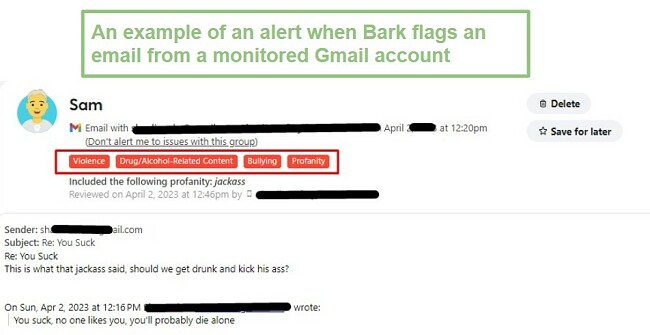
I found the monitoring on Google Drive to be especially helpful for detecting cyberbullying. If a classmate left a mean comment on a group project or if he was venting on a Google Doc, the content that triggered the filter appeared in my dashboard.
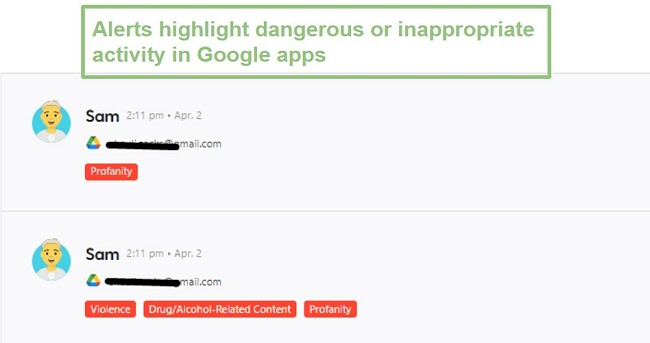
Bark has a powerful filter that monitors what websites my son visits on Google Chrome (and other major browsers). It blocks any site that triggers its filters and sends me an alert, so I can talk with my son about why it was blocked.
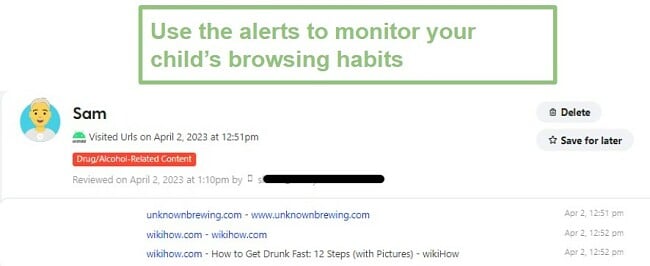
Bark also integrates SafeSearch and YouTube Restricted Mode into its platform. Not only is it more convenient to keep all the parental controls in one location, but it also prevents my son from disabling these tools through his Google account.
Instead of just blocking or taking away his phone, Bark has a customizable screen time routine. There are four screen time usage categories that I can enforce during specific time periods. For example, the School Time category blocks all social media and entertainment apps and websites but allows my son to use Google Drive and access educational websites. However, for an hour after school, I set up Free Time which unblocks all age-appropriate content.
If you aren’t sure if Bark is the right choice for you and you want to test it for yourself, you can download Bark and try it free for 7 days. This will give you enough time to connect it to your child’s Google account, monitor the content and learn about their online behavior.
2. Qustodio: Set Screen Time Limits and Content Filters for Google and Other Apps
- Set general screen time limits or customize if for each app
- Tracks keywords used in Google searches
- Powerful content filters block inappropriate websites
- Try it free for 30 days – no credit card required!
Qustodio has a powerful collection of parental control tools that can be enforced on all Google products. From setting screen time limits to blocking websites, it gives me peace of mind because it’s easy to set up and difficult for my son to bypass.
I found that with Qustodio, monitoring my child’s search queries on Google has never been easier. It tracks which words my son uses to search and how many times each word is used. The dashboard provided me with comprehensive reports on the search terms used, enabling me to identify any potential red flags.
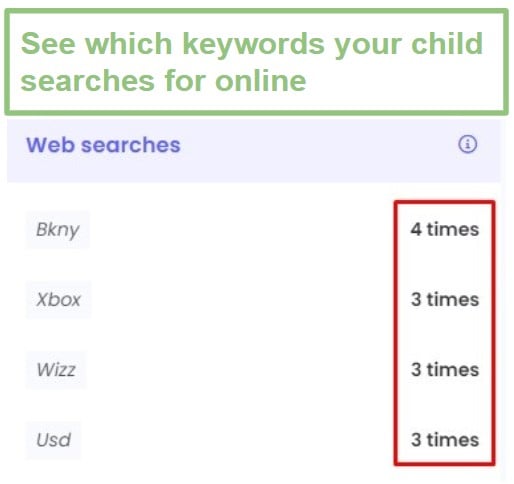
In terms of setting time limits on Android devices, Qustodio has several different options. I could set general daily screen time limits for my child and set aside restricted time when the phone will be blocked. While Qustodio can’t read my son’s email or chats like Bark, it gives me the ability to block or set screen time limits for individual apps. This is helpful if I see that my son is watching hours of YouTube and I want to limit his video watching to an hour or if he downloaded an app that I don’t approve of and want to block.
Qustodio generates a report that details the Youtube search history and videos viewed. It includes the title, description, and a thumbnail of the video so I can watch it for myself to see what type of videos my son is watching. While Qustodio can only monitor the YouTube app on Android, I can block the website through the web filter, so my son can only watch through the app, and I’ll be able to see the reports.
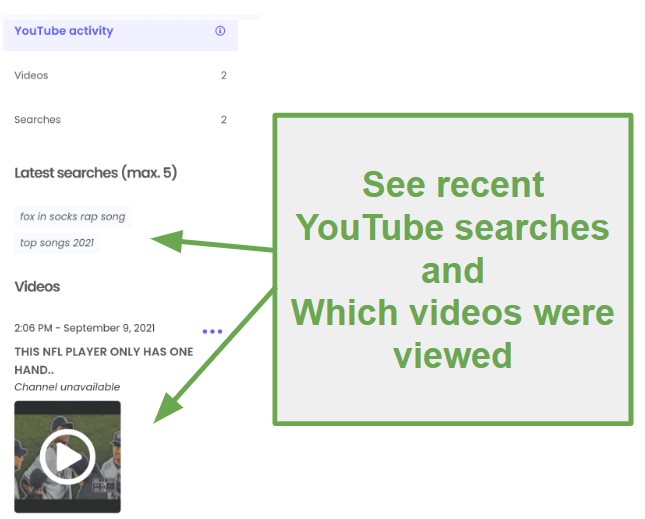
Qustodio is compatible with a wide range of Google products. From Chromebooks to Android smartphones and tablets, Qustodio provides a consistent and reliable parental control experience. Additionally, it has apps for iOS, Windows, and macOS, which means I can manage and monitor my son’s digital life regardless of the device he uses.
I took advantage of the Qustodio 30-day free trial, with no credit card required, to test the app and see firsthand how it works. You can do the same and get unlimited access to all the premium features to enforce your parental control rules for Google.
Try Qustodio Free for 30 Days!
3. mSpy: Keylogger and Screenshots Show Everything Your Child Does On Google
- Create a list of words or phrases that will trigger an alert when used in searches or chats
- Detailed reporting includes browser history, call logs, and a list of installed apps
- 14-day money-back guarantee
After testing the mSpy parental control app, I discovered that it provides a unique approach to monitoring my child’s online activities compared to other solutions like Bark and Qustodio. Rather than imposing strict rules on my child’s phone, mSpy provides me with an inside look at their online activities, giving me the necessary insight to make informed decisions about their safety.
One of the standout features of mSpy is its keylogger functionality, which records every keystroke made on my child’s device. This enables me to monitor what they search for on Google, ensuring I’m aware of any potentially harmful content. Additionally, mSpy’s screenshot feature provides me with visual evidence of their online activities, which proves invaluable in understanding their digital behavior.
I was also impressed with mSpy’s ability to monitor my child’s email communications. This means I can keep an eye on incoming and outgoing messages, as well as any attachments, helping me to identify potential threats or inappropriate content.
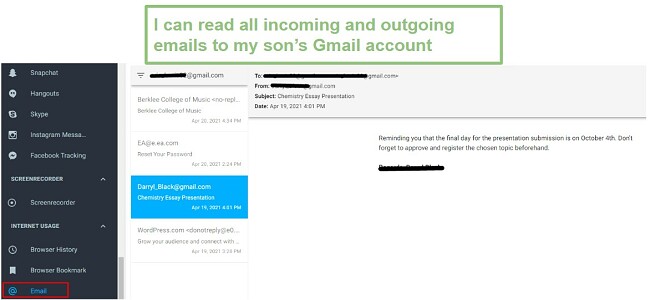
One major improvement that mSpy has made is keyword tracking. I can enter a word or phrase, and if my son enters those words in a Google search or they’re used in incoming or outgoing emails, chats, message boards, and social media interactions, I’ll get an instant notification. I used this to track words associated with cyberbullying, alcohol and drug abuse, violence, and depression, to name a few. It also gives me the option to block websites on Chrome and apps on my son’s Android phone and tablet.
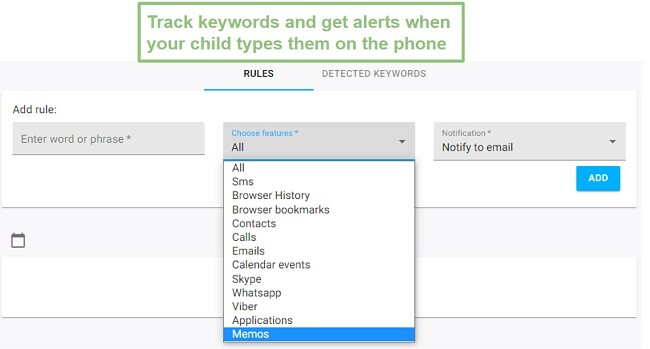
It’s important to note that mSpy does not have traditional parental control features such as screen time limits or a category-based web filter. It will only block URLs that I add myself.
mSpy offers a powerful and discreet solution, which is helpful for parents who want to gain insight into their child’s online activities without imposing strict limitations. Its keylogger, screenshot, and email monitoring features make it a valuable tool for keeping a watchful eye on your child’s digital life, particularly when it comes to Google searches and Android devices. If you want to try mSpy, it comes with a 14-day money-back guarantee. However, this is not a “no questions asked” policy, so you must provide a good reason for canceling your account to receive a refund.
Try mSpy Risk Free for 14 Days
Are Google’s Parental Control Features Good Enough?
If Google’s tools, such as Family Link and SafeSearch, were truly effective, implementing parental control on their products would be a breeze. However, they offer only the minimum level of protection, and many kids can easily circumvent these basic rules. It’s important to remember that children are also consumers for Google, and the company aims to prevent them from switching to alternatives like Bing or choosing an iPhone over an Android as they grow older. As a result, Google provides these parental control tools but doesn’t invest enough resources in making them truly efficient.
Is SafeSearch good at Filtering Search Results?
SafeSearch can be helpful in blocking a significant amount of explicit content, but it’s not perfect. Sometimes, inappropriate content can still slip through the cracks, and on the flip side, it may over-filter and block some harmless websites. Besides, SafeSearch only works on Google’s search engine, meaning that if my kids use another search engine or access explicit content through direct links, SafeSearch won’t be of any help.
Can I Trust Google Family Link to Monitor Apps and Websites?
Family Link is Google’s weak attempt at offering a parental control app. It has location tracking and limited screen time rules. However, Family Link works on devices running Android 7.0 or later, and it requires both parent and child to have a Google account. Additionally, Family Link may not be able to block certain apps or features on some devices, and it does not provide content filtering or monitoring for non-Google apps. But perhaps the biggest flaw in the app is that it sends kids an email when they turn 13 saying they can disable Supervision. Once they disable the supervision, their account is removed from the parent’s account, and it removes all parental control rules.
Another easy way for kids to bypass the Family Link is by simply opening a new Google account. If they’re under 13, they can just add a fake birthday, so there’s no need to connect to an adult’s account.
Can I Trust Chrome Filtering to Block Apps and Websites?
Chrome offers built-in parental controls that allow you to block certain websites, set up safe search, and restrict downloads and extensions. However, these controls are not foolproof. Children may still be able to access blocked sites through proxies or VPNs. Additionally, the controls may not work on other browsers, and Chrome does not offer content filtering for YouTube.
Does YouTube’s Restricted Mode Block all Inappropriate Videos?
YouTube offers a range of parental controls, including Restricted Mode, which filters out mature content, and YouTube Kids, which is a separate app designed for children. However, these controls are not perfect. Restricted Mode is not 100% accurate and may still allow some inappropriate content to slip through. YouTube Kids may still have some inappropriate content, and children may also be exposed to ads and comments that are not appropriate for their age.
Will the Play Store Really Block Downloads Based on Age Rating?
The Play Store offers parental controls that allow you to restrict access to certain apps and content based on age rating. However, these controls may not be effective in preventing children from downloading inappropriate apps or content. Some apps may be mislabeled, and some content may not have an age rating. Additionally, children may still be able to access restricted content through third-party app stores or file-sharing sites.
FAQ
Is there a free way to set parental control rules on Google?
Can my child bypass the parental controls on Google products?
How can I make sure my child is not accessing inappropriate content on Google Chrome?
The best way to block inappropriate content is with a premium parental control app that has a comprehensive web filter. After extensive testing, Bark proved to be the best option. Its AI filter understands context and focuses on child health issues, cyberbullying, violence, and inappropriate content. The filter is very good, and my kids weren’t able to find a way to bypass it, including using a VPN, incognito mode, or switching from Chrome to a different browser. You can try Bark free for 7 days and see how easy the filter is to set up and manage for yourself.
Using a Premium Parental Control App is the Best Practice For Monitoring Google Products
While Google provides some basic tools like Family Link and SafeSearch, they may not offer the necessary level of protection, and children may still find ways to circumvent them. To ensure comprehensive protection, it’s advisable to use a premium parental control app in combination with Google products.
Out of all the apps and methods I tested, Bark stands out as the best and most reliable option. The user-friendly app connects with Google apps and uploads any content or images that trigger its filter. Additionally, it has an excellent web filter, customizable screen time tools, and detailed reporting on my sons’ online activity. You don’t have to take my word for it. You can try Bark yourself completely free for 7 days through this link. This will give you enough time to set some rules on Google and see how easy it is to monitor your child’s online activity and make sure they are safe.

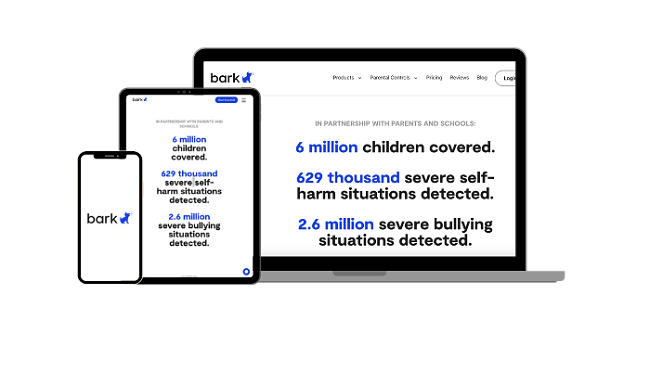
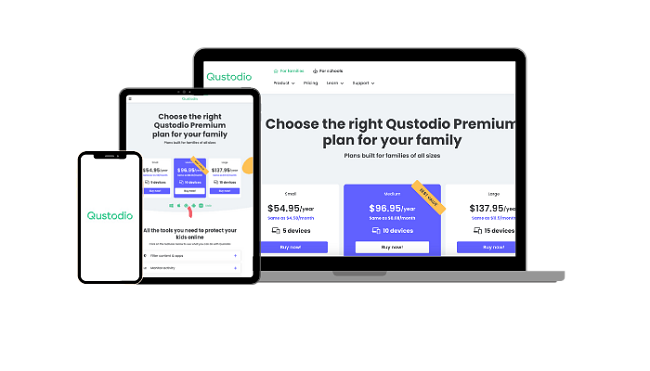





Leave a Comment
Cancel